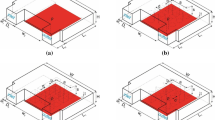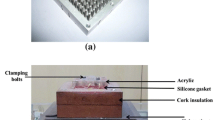Abstract
An experimental apparatus was set up to analyze heat sinks commercialized in the Brazilian market for use in personal computers. Among the identified geometries, all in the configuration of plate-fin heat sink, five stood out for being the most used. The experiment was performed in plate-fin heat sinks subjected to horizontal parallel air flow by changing the velocity of the wind tunnel in the range of 0 to 8 m/s. A constant power at 1,000 W was provided to simulate the heat generated by electronic components. During the heat exchange by natural convection, the heat flux supplied to a heat sink base was in the range between 31,000 W/m2 and 43,100 W/m2, while for forced convection the values varied between 23,300 W/m2 and 73,800 W/m2. For natural convection, a correlation was suggested for the average Nusselt number, valid in the range of 3 < Ra < 35 with RMS of 10.1%. For forced convection, two correlations were developed, one without the use of correction, which presented an RMS of 23.4%, and the other with a correction factor with RMS of 7.6%; both valid in the range of 2,000 < Pe < 14,000. The uncertainties related to the instruments used were calculated with the highest value found being 1%, while the uncertainty related to the variables was 22.9%. A theoretical model for forced convection was developed using mass and energy conservation equations. The pressure loss and the deviation factor were determined considering the following assumptions: steady-state and fully developed flow, turbulent flow in the bypass (flow in the duct outside the heat sink channels), flow in the heat sink channels as laminar, incompressible, viscous, and internal, as in ducts, and constant fluid properties. The results showed a higher growth rate of the total pressure drop for heat sinks with an LZ/S ratio between 9.9 and 18.1 and with uniform spacing between the fins. For Reynolds number values less than 2,000, forced convection is no longer dominant, and the development of a thermal design in this region must focus on a mixed or natural convection.












Similar content being viewed by others
Abbreviations
- a:
-
Constants for the correction factor, dimensionless
- A:
-
Area, m2
- b:
-
Constants for the correction factor, dimensionless
- BF:
-
Bypass factor, dimensionless
- c:
-
Constants for the correction factor, dimensionless
- C:
-
Constant, dimensionless
- D:
-
Diameter, m
- f:
-
Friction coefficient, dimensionless
- F:
-
Correction factor, dimensionless
- g:
-
Gravity acceleration, m/s2
- h:
-
Heat transfer coefficient, W/m2K
- H:
-
Tunnel height, m
- K:
-
Loss coefficient, dimensionless
- L:
-
Length, m
- N:
-
Number of fins
- Nu:
-
Nusselt number, dimensionless
- Q:
-
Volumetric flow rate, m3/s
- p:
-
Perimeter, m
- P:
-
Pressure, Pa
- Pe:
-
Peclet number, dimensionless
- Pr:
-
Prandtl number, dimensionless
- q" :
-
Heat flux, W/m2
- R:
-
Dependent variables
- Ra:
-
Rayleigh number, dimensionless
- Re:
-
Reynolds number, dimensionless
- RMS:
-
Root mean square, [%]
- S:
-
Fin spacing, m
- T:
-
Temperature, ºC
- t:
-
Thickness, m
- u:
-
Average uncertainty, %
- V:
-
Velocity, m/s
- X:
-
Spatial coordinates, m
- x1, x2,…xn :
-
Independent variables
- W:
-
Tunnel width, m
- Y:
-
Spatial coordinates, m
- Z:
-
Spatial coordinates, m
- \(\alpha\) :
-
Thermal diffusivity—air, m2/s
- \(\beta\) :
-
Expansion coefficient—air, K−1
- \(\kappa\) :
-
Thermal conductivity—fluid or solid, W/mºC
- \(\lambda\) :
-
Dependent variable for the correction factor, dimensionless
- \(\mu\) :
-
Dynamic viscosity, Ns/m2
- \(\nu\) :
-
Kinematic viscosity—air, m2/s
- \(\rho\) :
-
Density, kg/m3
- \(\Delta\) :
-
Difference
- AN:
-
Anemometer
- C:
-
Clearance
- CP:
-
Copper
- CT:
-
Contraction
- D:
-
Bypass
- e:
-
Flow development region
- EP:
-
Expansion
- EXP:
-
Experimental
- f:
-
Fluid
- FC:
-
Forced convection
- H:
-
Hydraulic
- HE:
-
Heating element
- HS:
-
Heat sink
- NC:
-
Natural convection
- R:
-
Dependent variables
- S:
-
Surface
- T:
-
Total
- TS:
-
Test section
- x1, x2,…xn :
-
Independent variables
- X, Y, Z:
-
Direction
- 1 to 5:
-
Heat sink model
- m n:
-
Constant
References
Yüncü H, Anbar G (1998) An experimental investigation on the performance of rectangular fins on a horizontal base in free convection heat transfer. Heat Mass Transf 33:507–514
Sadrabadi Haguigui S, Goshayeshi HR, Safaei MR (2018) Natural convection heat transfer enhancement in new designs of plate-fin based heat sinks. IJHMT 125:640–647
Kim TH, Do KH, Kim D-K (2011) Closed form correlations for thermal optimization of plate-fin heat sinks under natural convection. IJHMT 54:1210–1216
Joo Y, Kim SJ (2015) Comparison of thermal performance between plate-fin and pin-fin heat sinks in natural convection. IJHMT 83:345–356
Tari I, Mehrtash M (2013) Natural convection heat transfer from inclined plate-fin heat sinks. IJHMT 56:574–593
Tari I, Mehrtash M (2013) Natural convection heat transfer from horizontal and slightly inclined plate-fin heat sinks. Appl Therm Eng 61:728–736
Jeon D, Byon C (2017) Thermal performance of plate fin heat sinks with dual-height fins subject to natural convection. IJHMT 113:1086–1092
Feng S, Shi M, Yan H, Sun S, Li F, Lu TJ (2018) Natural convection in a cross-fin heat sink. Appl Therm Eng 132:30–37
Chen H-T, Tseng H-C, Jhu S-W, Chang J-R (2017) Numerical and experimental study of mixed convection heat transfer and fluid flow characteristics of plate-fin heat sinks. IJHMT 111:1050–1062
Li H-Y, Chao S-M (2009) Measurement of performance of plate-fin heat sinks with cross flow cooling. IJHMT 52:2949–2955
Chen H-T, Lai S-T, Haung L-Y (2013) Investigation of heat transfer characteristics in plate-fin heat sink. Appl Therm Eng 50:352–360
Bassiouny R, Maher H, Hegazy AA (2016) On the thermal analysis of a plate-fin heat sink considering the thermal-entry length effect. Appl Therm Eng 99:273–279
Limbasiya N, Roy A, Harichandan AB (2017) Numerical simulation of heat transfer for microelectronic heat sinks with different fin geometries in tandem and staggered arrangements. Appl Therm Eng 4:11–17
Kanargi B, Lee PS, Yap C (2018) A numerical and experimental investigation of heat transfer and fluid flow characteristics of an air-cooled oblique-finned heat sink. IJHMT 116:393–416
Hussain AA, Freegah B, Khalaf BS, Towsyfyan H (2019) Numerical investigation of heat transfer enhancement in plate-fin heat sinks. Effect of flow direction and fillet profile. Case Stud Therm Eng 13:100388
Sukumar RS, Sriharsha G, Arun SB, Kumar PD, Naidu CS (2013) Modelling and analysis of heat sink with rectangular fins having through holes. Int J Eng Res Appl 3:1557–1561
Castelan A, Cougo B, Dutour S, Meynard T (2019) 3D analytical modelling of plate fin heat sink on forced convection. Math Comput Simul 158:296–307
Kim D-K, Jung J, Kim SJ (2010) Thermal optimization of plate-fin heat sinks with variable fin thickness. IJHMT 53:5988–5995
Wu H-H, Hsiao Y-Y, Huang H-S, Tang P-H, Chen S-L (2011) A practical plate-fin heat sink model. Appl Therm Eng 31:984–992
Ahmed HE (2016) Optimization of thermal design of ribbed flat-plate fin heat sink. Appl Therm Eng 102:1422–1432
Ahmed HE, Salman BH, Kherbeet AS, Ahmed MI (2018) Optimization of thermal design of heat sinks: a review. IJHMT 118:129–153
Lampio K, Karvinen R (2017) Optimization of convectively cooled heat sinks. Microelectron Reliab 79:473–479
Elshafei EAM (2007) Effect of flow bypass on the performance of a shrouded longitudinal fin array. Appl Therm Eng 27:2233–2242
White FM (1999) Fluid mechanics. McGraw-Hill Companies Inc, New York
Incropera FP, DeWitt DP (2002) Fundamentals of heat and mass transfer. John Wiley & Sons Inc, Nova Jersey
Latzko H, Angew Z (1921) Math Mech 1:268–290
Bhatti MS, Shah RK (1987) Turbulent and transition flow convective heat transfer in ducts. In: Kakaç S, Shah RK, Aung W (eds) Handbook of Single-Phase Convective Heat Transfer. Wiley Interscience, New York
Zhi-qing W (1982) Study on correction coefficients of laminar and turbulent entrance region effects in round pipes. Appl Mathemat Mech 3:433
Holman JP (2012) Experimental methods for engineers. McGraw-Hill Companies Inc, New York
Freegah B., Hussain, A. A., Falih, A. H., Towsyfyan H. (2019) CFD Analysis of heat transfer enhan cement in plate-fin heat sinks with fillet Profile: investigation of new designs. Thermal Science and Engineering Process. TSEP 100458.
Acknowledgements
The authors would like to acknowledge CNPq (call MCT/CNPq 014/2010) and FAPERJ (call 19/2008) for financial support during this work. They would also acknowledge Mr. Daniel Chaves de Oliveira, an undergraduate in Mechanical Engineering at FAT/UERJ, for his help in performing the experimental work.
Author information
Authors and Affiliations
Corresponding author
Additional information
Technical Editor: Jose A. R. Parise.
Publisher's Note
Springer Nature remains neutral with regard to jurisdictional claims in published maps and institutional affiliations.
Rights and permissions
About this article
Cite this article
Leite, N.G.C., Reis, L.C.B.S. & Machado, H.A. Theoretical–experimental study of commercial heat sinks for personal computers. J Braz. Soc. Mech. Sci. Eng. 43, 463 (2021). https://doi.org/10.1007/s40430-021-03181-4
Received:
Accepted:
Published:
DOI: https://doi.org/10.1007/s40430-021-03181-4




